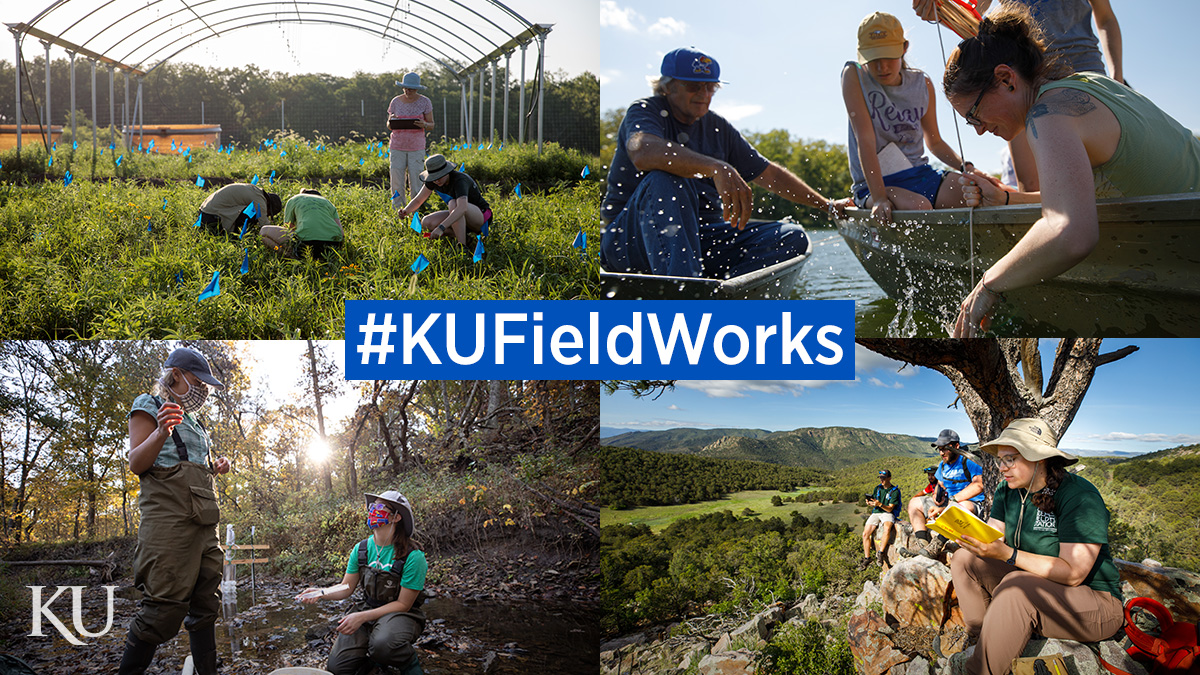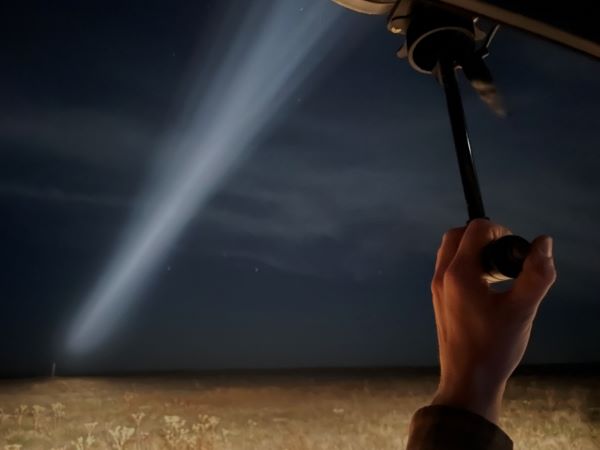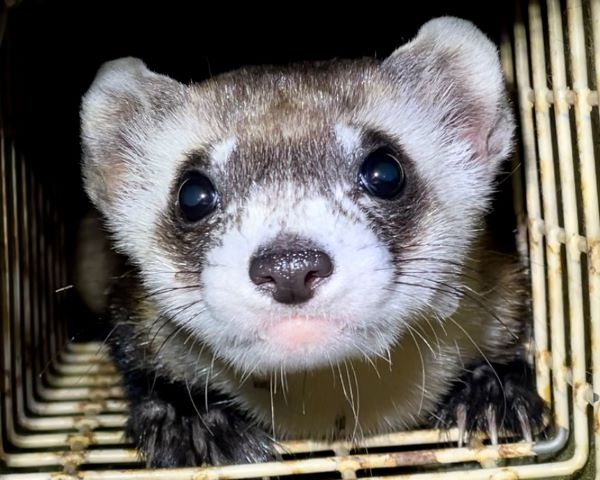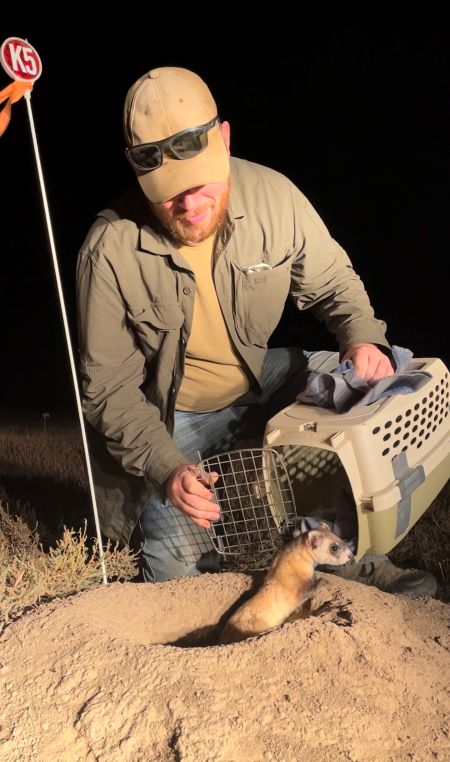#KUFieldWorks: Surveying the Kansas ferret population to improve conservation

Editor’s note: Fieldwork provides invaluable insights about real-world environments and processes, expanding and reinforcing what researchers learn in classrooms, labs and collections. KU faculty, staff and students across a spectrum of disciplines are taking their inquiry directly to rivers, prairies, dig sites, glaciers, islands, archives and more this summer. Through the #KUFieldWorks series, we'll join them on their adventures.
Q&A with Wendy Holman, education program coordinator, KU Field Station
LAWRENCE — Black-footed ferrets are one of the most endangered mammals in North America and were twice thought to be extinct, though they used to be widely distributed across the grasslands of the Great Plains. Since their (re)rediscovery in 1981, the survival of the species has been dependent on the continued effort of various organizations dedicated to their captive breeding, cloning, reintroduction, and protection. Despite these efforts, black-footed ferrets are still scarce due to habitat loss, destruction of prairie dog colonies, and diseases like sylvatic plague. Ferrets depend entirely on prairie dog colonies for food and shelter, and prairie dog colonies are in short supply. It is estimated that one female ferret requires 200 acres of healthy prairie dog colony to successfully hunt for herself and raise kits. Sylvatic plague can spell disaster for a prairie dog colony and all of the ferrets who rely on it.
Kansas has one of the most successful reintroduction sites because it is on private land where the prairie dogs are protected and does not have issues with plague. Each year, a team of people from organizations including the U.S. Fish & Wildlife Service, the National Black-footed Ferret Conservation Center, several Kansas zoos accredited by the Association of Zoos & Aquariums, and others gather to perform intensive nighttime surveys of a reintroduction site in western Kansas.
What methods, approaches, experiments, etc. are you using?
From 8 p.m. – 7 a.m. during the yearly survey, teams slowly drive vehicles through prairie dog colonies, using powerful spotlights to sweep the area and look for the tell-tale emerald green eyeshine of a black-footed ferret. When a ferret is spotted, a live trap is set in the prairie dog burrow that the ferret scurried down. Any adjacent burrows are plugged so that the ferret cannot simply slip off into the night undetected. If a ferret is successfully trapped, it is scanned for a microchip using a ring reader that will identify the individual. Ferrets who have not yet been chipped are wild-born individuals who are then transported to a vet trailer where they are given a physical exam, vaccinated against rabies and sylvatic plague, and given a unique microchip so they can be identified if they are trapped again in the future. The ferret is then returned to the exact same burrow where it was trapped and released. The data collected through these surveys is used by the recovery team to determine future releases.

Why does your study matter to your field or for society?
These surveys matter immensely to the survival of black-footed ferrets. Black-footed ferrets are a crucial part of the ecosystem in the Great Plains. By protecting them, we also protect the prairie ecosystem and its biodiversity, which benefits other species and contributes to the overall health of the environment. As a society, we have an ethical responsibility to protect and conserve endangered species, especially when their survival is threatened by our actions. Being able to share these stories is important in helping people understand the importance of conservation efforts like these.
What do you enjoy most about being in the field?
Being in the field for a project like this allows me to have a direct impact in local conservation efforts. I feel lucky to be able to contribute, in a small way, to black-footed ferret recovery. I love wildlife encounters, and you can see some incredible things if you spend a lot of time in the field. I love being able to learn new things, and it is hard not to learn something new when you are in the field. I also really enjoy being without internet or phone access because it allows me to focus on what I am doing and the people who I am with.

What are some memorable (funny, scary, surprising, etc.) moments from the field?
We have seen some really interesting interactions between species. One of my favorites is getting to watch coyote/badger interactions. These two species are known to hunt collaboratively, and we have been lucky enough to see this several times. Coyotes are quick and nimble and excel at hunting on the open prairie, while badgers are excellent diggers and specialize in hunting underground. Rodents, like prairie dogs or ground squirrels, respond differently to each predator. A prairie dog fleeing a coyote will seek refuge in a burrow, but a prairie dog faced with a badger will try to escape to the surface. In either scenario, the other predator is ready to pounce. By combining their different hunting strategies, both coyote and badger get more food while spending less energy than when hunting alone.
Last year, we saw a badger that had just kicked a large, chilly prairie rattlesnake out of a prairie dog burrow that it was digging in. The rattlesnake was cold but rattling constantly just inches from the badger, and the badger had absolutely not a care in the world about us or the snake, even though we were only about 10 feet away.
These surveys are done on a private ranch that does rotational cattle grazing, which means that there are wire fence lines running all throughout the survey plots. We have had some close calls in the wee hours of the morning when we are tired, and our eyes are bleary, and a fence line suddenly appears right in front of us. Luckily we never drive more than 10 mph on surveys, but it would be embarrassing to take out a fence!
When is fieldwork frustrating, challenging or overwhelming?
A challenging part of black-footed ferret surveys is the abrupt switch to a nocturnal schedule. We drive from Lawrence to western Kansas, and then roll straight into a full night of surveys. We tried camping our first year but got cooked out of our tents by 10 or 11 a.m., meaning we were only sleeping two to three hours per day and driving 12-hour nights during surveys. We learned our lesson and booked hotel rooms so that we could actually get good sleep, and that made a world of difference. Audiobooks, night snacks, midnight coffees, and lots of conversation are helpful, but nothing perks you up quite like an emerald green eyeshine or a ferret in a trap!
There is no guarantee that you will see, let alone trap, a ferret. Last year, we checked on one trap every hour for two full nights, with no ferret or any other ferret sighting. We knew that the ferret had either escaped from an unblocked hole near the trap or was cozy down in the burrow with a prairie dog meal. That got frustrating, but our patience paid off on our final check of that trap before finishing the survey when we saw the eyeshine coming from inside. We had trapped a wild-born male!
There are an estimated 300-400 black-footed ferrets living in the wild across their current range, but biologists believe that this number needs to be closer to 3,000 to give the species some stability and a chance of true recovery. It is easy to become overwhelmed and slip into pessimism when faced with numbers like that, but the data collected at this release site shows survivorship, reproduction, and dispersal across the available habitat — all encouraging signs for a species in trouble.

How does fieldwork complement the work you do elsewhere?
As the Education Program Coordinator for the KU Field Station, part of my job is sharing research with the broader community. By participating in research projects like this, I can share first-hand experiences that better connect people with our local wildlife and ecosystems.
First photo: University of Kansas researchers conduct fieldwork in prairies, rivers, streams and mountains. The #KUFieldWorks series follows researchers on their fieldwork adventures.
Second photo: Wendy Holman sweeps a spotlight across the prairie, looking for eye shine. Photo by Wendy Holman
Third photo: A young, wild-born male ferret peers out of a trap. Wendy Holman and Nathaniel Weickert caught this ferret at the very last trap check of the survey. Photo by Wendy Holman
Fourth photo: Nathaniel Weickert releases a freshly microchipped and vaccinated wild-born male ferret back into the burrow where he was trapped. Photo by Wendy Holman